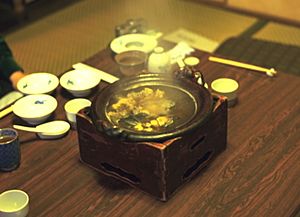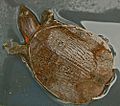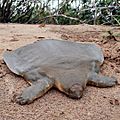Trionychidae facts for kids
Quick facts for kids Trionychidae |
|
|---|---|
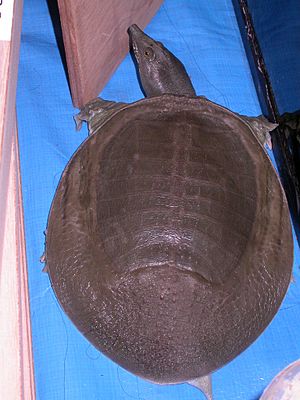 |
|
| Chinese softshell turtle Pelodiscus sinensis |
|
| Scientific classification |
|
| Kingdom: | Animalia |
| Phylum: | Chordata |
| Class: | Reptilia |
| Order: | Testudines |
| Suborder: | Cryptodira |
| Superfamily: | Trionychia |
| Family: | Trionychidae Fitzinger, 1826 |
| Subfamilies | |
|
|
The Trionychidae are a group of turtles commonly known as softshell turtles. This family was named by Leopold Fitzinger in 1826. Softshell turtles include some of the biggest freshwater turtles in the world. Many can also live in water that is a bit salty, called brackish water. You can find these turtles in Africa, Asia, and North America. Most species used to be in the genus Trionyx, but they have since been moved to other groups. For example, the North American Apalone softshells were in Trionyx until 1987.
Contents
What Makes Softshell Turtles Special?
Softshell turtles get their name because their carapace (the top part of their shell) doesn't have hard, bony scales. Instead, it's leathery and flexible, especially on the sides. Even though it's soft, the middle part of their shell still has a layer of strong bone, just like other turtles. The edges, however, are softer. Some species also have small bones in their plastron (the bottom part of their shell), but these aren't attached to the main shell bones.
This light and flexible shell helps them move easily in water or on muddy lake bottoms. It also lets them move much faster on land than most other turtles. Their feet are webbed, and they have three claws on each foot. This is why their family name, "Trionychidae," means "three-clawed." The color of a softshell turtle's shell often matches the sand or mud where it lives. This helps them hide and wait for their food.
How Softshell Turtles Live in Water
These turtles have many features that help them live in water. Many need to be underwater to swallow their food. They have long, soft, snorkel-like noses. Their necks are very long compared to their bodies. This allows them to breathe air from the surface while their bodies stay hidden in the mud or sand below.
Female softshell turtles can grow very large, with shells several feet wide. Males, however, stay much smaller. This difference in size between males and females is called sexual dimorphism. The Pelochelys cantorii, found in Southeast Asia, is the largest softshell turtle.
Most softshell turtles are carnivores, meaning they eat meat. Their diet mainly includes fish, water bugs, snails, amphibians, and sometimes even birds or small mammals.
Softshell turtles can also "breathe" underwater. They do this by moving their mouth cavity rhythmically. Inside their mouths, they have many small parts with lots of blood vessels. These work like the gills of a fish, helping them take in oxygen from the water. This lets them stay underwater for a long time. The Chinese softshell turtle, for example, can even get rid of urea (a waste product) while breathing underwater. This is very helpful when they are in salty water and can't easily get fresh water.
According to Raymond Ditmars, a naturalist, in 1910, many softshell turtles have very strong jaws. These jaws help them crush tough prey like snails. Because of their powerful jaws, large softshell turtles can give a very strong bite.
Unlike most turtles, where the temperature of the nest determines if a baby turtle is male or female, softshell turtles have genetic sex determination. This means their sex is decided by their genes, with special small chromosomes playing a role.
Softshell Turtles as Food
Softshell turtles are eaten as a special food in many parts of the world, especially in East Asia. In China, they are often cooked in a stew with chicken. In the 1930s, people in Guangdong would import many turtles from Guangxi. They were considered a great treat, eaten stewed with almonds, roasted with chili sauce, or fried with bamboo shoots.
The most commonly eaten softshell species worldwide is the Chinese softshell turtle, Pelodiscus sinensis. A Japanese biologist, Kakichi Mitsukuri, noted in 1904 that the Japanese type of this turtle, called Trionyx japonicus at the time, was as popular in Japanese cooking as other famous turtles in different countries. By the late 1800s, the farming of this "delicious reptile," known as suppon in Japan, was already a big industry.
Because of high demand and too much hunting, the price of Pelodiscus sinensis in China became very high by the mid-1990s. To meet the demand, large-scale turtle farming started in China and nearby countries. Hundreds of millions of these turtles were raised, and soon the prices became more affordable again. Another species, Palea steindachneri, is also farmed in China, but on a smaller scale.
In the United States, catching softshell turtles (like the Apalone ferox) was allowed in Florida until recently. Environmental groups asked authorities to stop or limit this practice. The Florida Fish and Wildlife Conservation Commission then set a daily limit of 20 turtles for licensed harvesters. However, some people who care about turtles felt this was still too many. While some turtles were eaten locally, most were sent to other countries. In 2008, the Commission estimated that about 3,000 pounds of softshell turtles were sent out each week through Tampa International Airport.
New rules came into effect on July 20, 2009. These rules limit catching any wild turtles to one per person per day. They completely stop the collection of softshells (Apalone) from May through July. They also stop the trade of turtles caught from the wild. There is an exception for licensed turtle farms that need to catch wild turtles to use as breeding animals.
Some other US states have also put strict limits on trading wild turtles. In 2009, South Carolina passed a law that limits how many wild-caught turtles (including softshells and other species) a person can send to other states or countries. The limit is 10 turtles at one time and 20 turtles per person per year.
Softshell Turtle Families
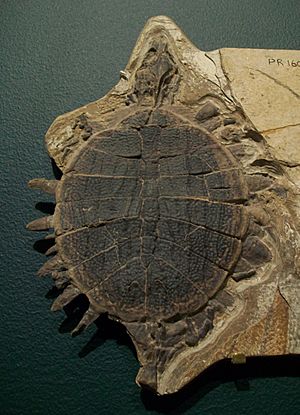
Scientists group living things into families and subfamilies. Here's how the softshell turtles are organized:
Family Trionychidae
- †Palaeotrionyx (an extinct group, meaning it no longer exists)
- Subfamily Plastomeninae (also extinct)
- Genus †Gilmoremys
- Genus †Hutchemys
- Genus †Plastomenus
- Subfamily Cyclanorbinae
- Genus Cyclanorbis
- Genus Cycloderma
- Genus Lissemys
- Subfamily Trionychinae
Old Classifications
- Genus Aspideretes (This group is now placed differently by scientists.)
Softshell Turtle Family Tree
Scientists use something called a cladogram to show how different groups of animals are related, like a family tree. This cladogram shows the relationships within the Trionychidae family, based on research by Walter G. Joyce, Ariel Revan, Tyler R. Lyson, and Igor G. Danilov in 2009.
| Trionychidae |
|
||||||||||||||||||||||||||||||||||||||||||||||||||||||||||||||||||||||||||||||||||||
Gallery
-
Pelodiscus sinensis in a Seoul market
See also
 In Spanish: Trioníquidos para niños
In Spanish: Trioníquidos para niños



